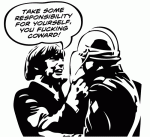There has been a great deal of media coverage relating to an FBI/DHS document detailing likely anarchist activity during the Republican National Convention and Democratic National Convention. The vast majority of that coverage has related to the threat of anarchists using Molotov cocktails, acid filled eggs, or even IEDs and IIDs. Normally any over stating and sensationalizing of the threat from anarchists comes from the media, but in this case, it appears it is the FBI/DHS who are responsible, most recently expressed in their Joint Intelligence Bulletin released August 21, 2012.
The document says:
“Violent criminal activity by anarchist extremists often occurs when small groups of extremists separate from larger, lawful protest groups and use ‘black bloc’ tactics to facilitate criminal activity or violence in furtherance of their ideology. Individuals egaging (sic) in ‘black bloc’ tactics typically dress completely in black and cover their faces with masks or bandannas to conceal their identity as they commit illegal acts such as vandalism, property destruction…”
That is a pretty basic, but accurate, description of how anarchists use the black bloc tactic. That paragraph then goes on to say:
“and occasionally, acts of violence, which have included throwing Molotov cocktails, flaming torches, or acid-filled eggs at law enforcement.”
This is where the FBI/DHS analysis becomes problematic. There have been no instances of anarchists throwing Molotov cocktails or acid filled eggs at police officers during any of the NSSE’s from the WTO protests in Seattle in 1999 until now or at any of the more recent events anarchists have been involved in.
The statement in the FBI/DHS report is not true as it relates to the United States. These things have happened but only in other countries where the anarchists are more numerous, better organized and much more aggressive. Within the United States, outside of some wishful thinking on Internet sites, there haven’t even been any plans by anarchists to attack police officers with potentially lethal weapons. The two cases at NSSEs where anarchists have been arrested for planning to use Molotov cocktails, their intended targets were buildings. This would still have been very dangerous, and it is a serious criminal offense, but it is not the direct attack on police officers as suggested in the FBI/DHS report.
So why does it matter that there may be some exaggeration in this document? Surely the fact that anarchists could potentially do these things is reason enough to include them in the warning. If the document merely pointed out that this was something that might happen but was unlikely, then that would be a fair question. However, it doesn’t. The document gives police officers the impression that it is something that has happened and is therefore likely to happen again and that is where it begins to have a worrying effect.
Many of the officers in Tampa will never have policed an event of this type before, many of them will never have policed an event where there are anarchists in any numbers. Understandably, there will be some degree of nervousness and trepidation about what to expect. Those officers will rely on the training and intelligence briefings they receive to assess the threat to them during incidents at protests and to help them decide how much force they should use to respond. Giving officers the impression they are likely to be attacked with potentially lethal weapons by anarchists within the protests is highly likely to lead to them making the wrong decisions about use of force and cause an overreaction, something that has the potential to affect everyone around them.
Policing protests where there are likely to be a mix of peaceful and cooperative protesters, non-violent and non-compliant protesters and a small number prepared to use vandalism and violence is challenging enough for the officers on the ground, without giving them incorrect information and making them worry about threats that are highly unlikely to be there. Intelligence is vital in preparing to police an event of this type, but that intelligence must be correct and must not sensationalize the threat. Otherwise, the overall policing of the event and the officers’ use of force is not likely to be proportionate to the actual problem encountered at both the RNC and DNC conventions.
Source: http://securitydebrief.com/2012/08/25/fbidhs-inaccuracy-could-lead-to-police-over-reaction/

